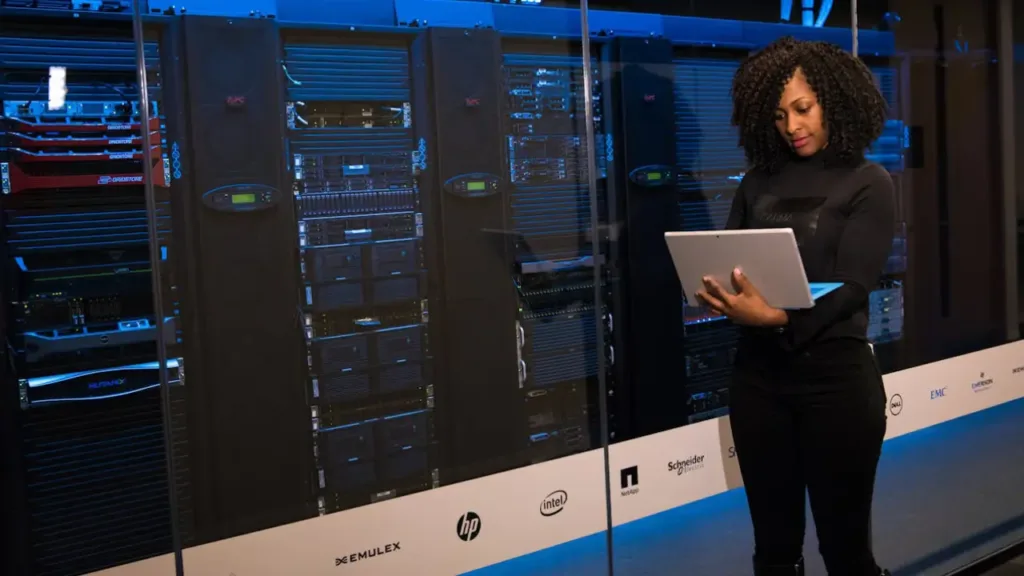introduction: The AI Revolution Demands Smarter Data Centers
The rise of artificial intelligence isn’t just transforming industries—it’s rewriting the rules for AI data center power and cooling solutions. By 2025, AI workloads will require 160% more power than traditional data centers, driven by trillion-parameter models like Meta’s Llama 3 and NVIDIA’s 250 kW GPU racks. In this guide, we’ll dissect the innovations redefining infrastructure for high-density workloads, from liquid cooling breakthroughs to nuclear-powered campuses.
1. AI Data Center Power and Cooling Solutions for High-Density Workloads 2025
Keyword Focus: AI data center power and cooling solutions for high-density workloads 2025
- Liquid Cooling Dominance:
- Immersion Cooling: Submerge 250 kW GPU racks in dielectric fluid (e.g., Meta’s Wyoming facility reduces PUE to 1.03).
- Direct-to-Chip (DTC): Coolant channels cut energy use by 40% vs. air cooling (Schneider Electric’s refrigerant systems).
- Hybrid Systems: Blend liquid/air cooling to retrofit legacy infrastructure (adopted by 67% of operators by 2025).
- Nuclear Power Integration:
- Small Modular Reactors (SMRs): Microsoft’s Wyoming project aims for 50 MW carbon-free power by 2030.
- Grid Partnerships: AWS collaborates with Duke Energy to offset 12 TWh annually via nuclear-solar hybrids.

2. AI-Driven Network Infrastructure: Solving the 1.6T Bottleneck
- 800G–1.6T Ethernet: Handle east-west traffic between 100,000+ GPUs (Keysight’s validation tools cut latency by 30%).
- Fiber Density: Deploy 4,000-fiber systems in 4RU racks (Cisco’s Nexus 9000 series).
Case Study: xAI’s Colossus supercomputer uses 16,000 NVIDIA H100 GPUs linked via 1.6T interconnects to train 100B-parameter models.
3. Location & Sustainability: The 2025 Mandate
- Renewable Energy Hubs: Latin America’s $10B data center boom targets solar/wind-rich regions like Chile.
- Waste Heat Recycling:
- Meta’s Iowa facility heats 500+ homes via server exhaust.
- Microsoft’s Stockholm DC recycles 95% of waste heat for district heating.
Regulatory Drivers: EU Taxonomy mandates PUE <1.2 for tax credits by 2026.
4. Workforce Gaps Meet AI Automation
- Predictive Maintenance: AI detects cooling pump failures 14 days in advance (Google’s DeepMind tools).
- GenAI for Ops: Lean teams manage 10x more racks using tools like NVIDIA’s Fleet Command.
5. The Future: Autonomous Data Centers & Edge AI
- Self-Optimizing Systems: AI adjusts cooling/power in real-time (IBM’s Project CodeFlare).
- Edge Integration: Process data closer to users with micro-modular DCs (HPE’s GreenLake).
FAQ Schema for Rich Snippets
Question 1: What are the best cooling solutions for AI data centers in 2025?
Answer: Immersion cooling and direct-to-chip systems reduce energy use by 40%, critical for 250 kW GPU racks in AI workloads.
Question 2: How does nuclear power support AI data centers?
Answer: Small modular reactors (SMRs) provide scalable, carbon-free energy—Microsoft’s Wyoming project delivers 50 MW by 2030.
Conclusion: Adapt or Fall Behind
The 2025 AI data center revolution hinges on power and cooling solutions for high-density workloads. From liquid-cooled GPU racks to AI-driven maintenance, operators must prioritize scalability and sustainability.
Ready to future-proof your infrastructure? Explore our guide to AI-native energy orchestration or share your thoughts below!
Also Read: Best free AI coding assistant for developers 2025: Kimi AI vs GPT-4 & Claude 3.5